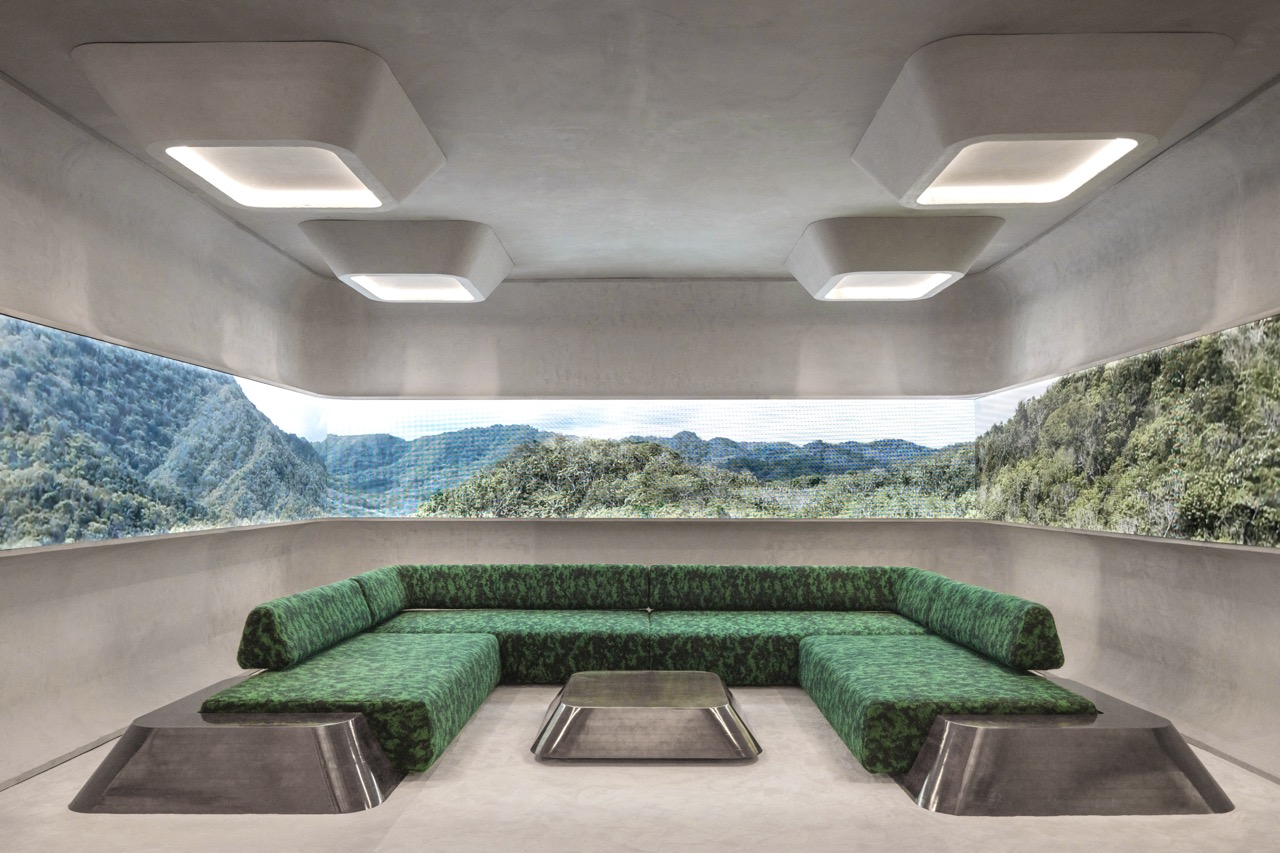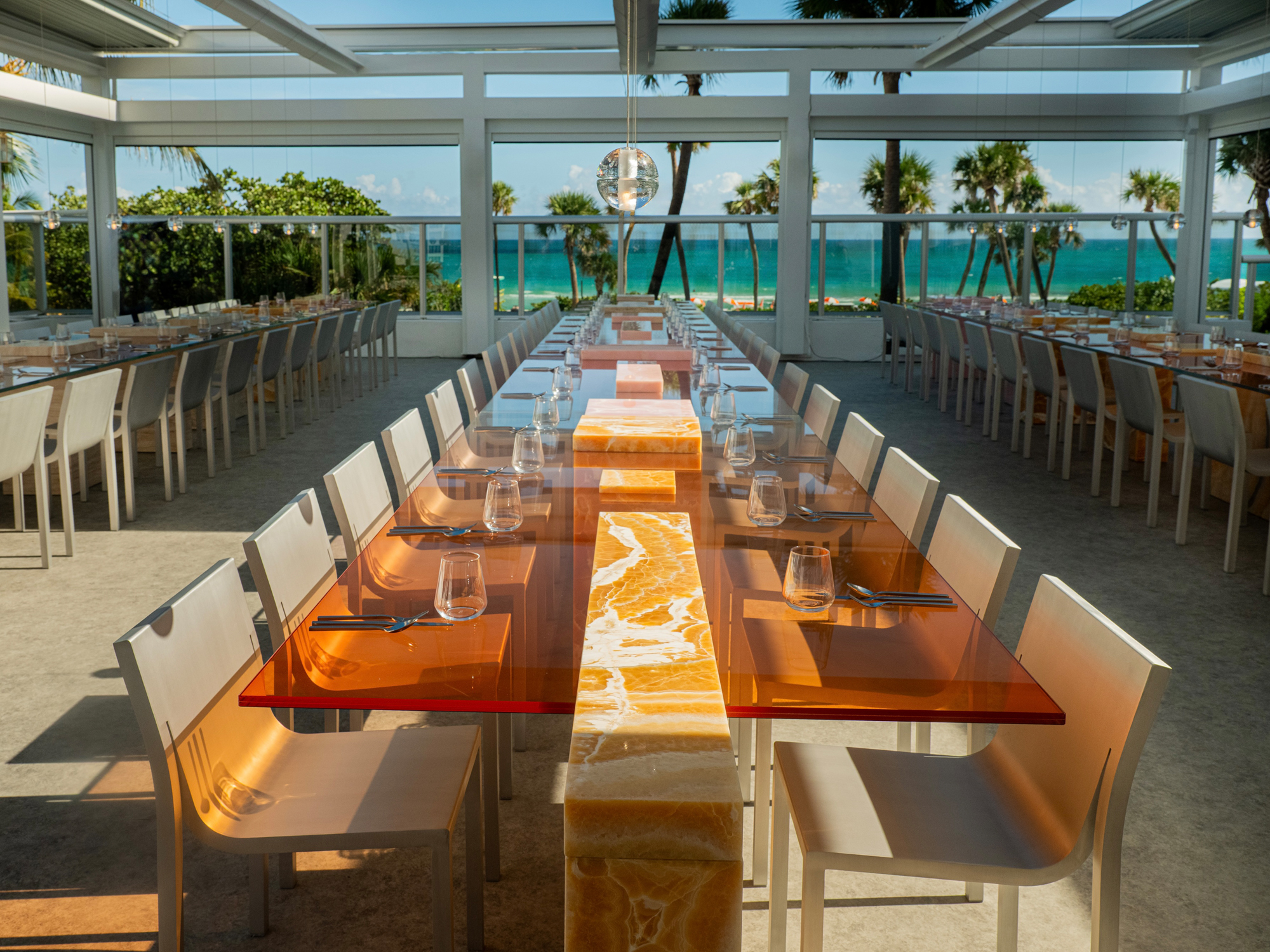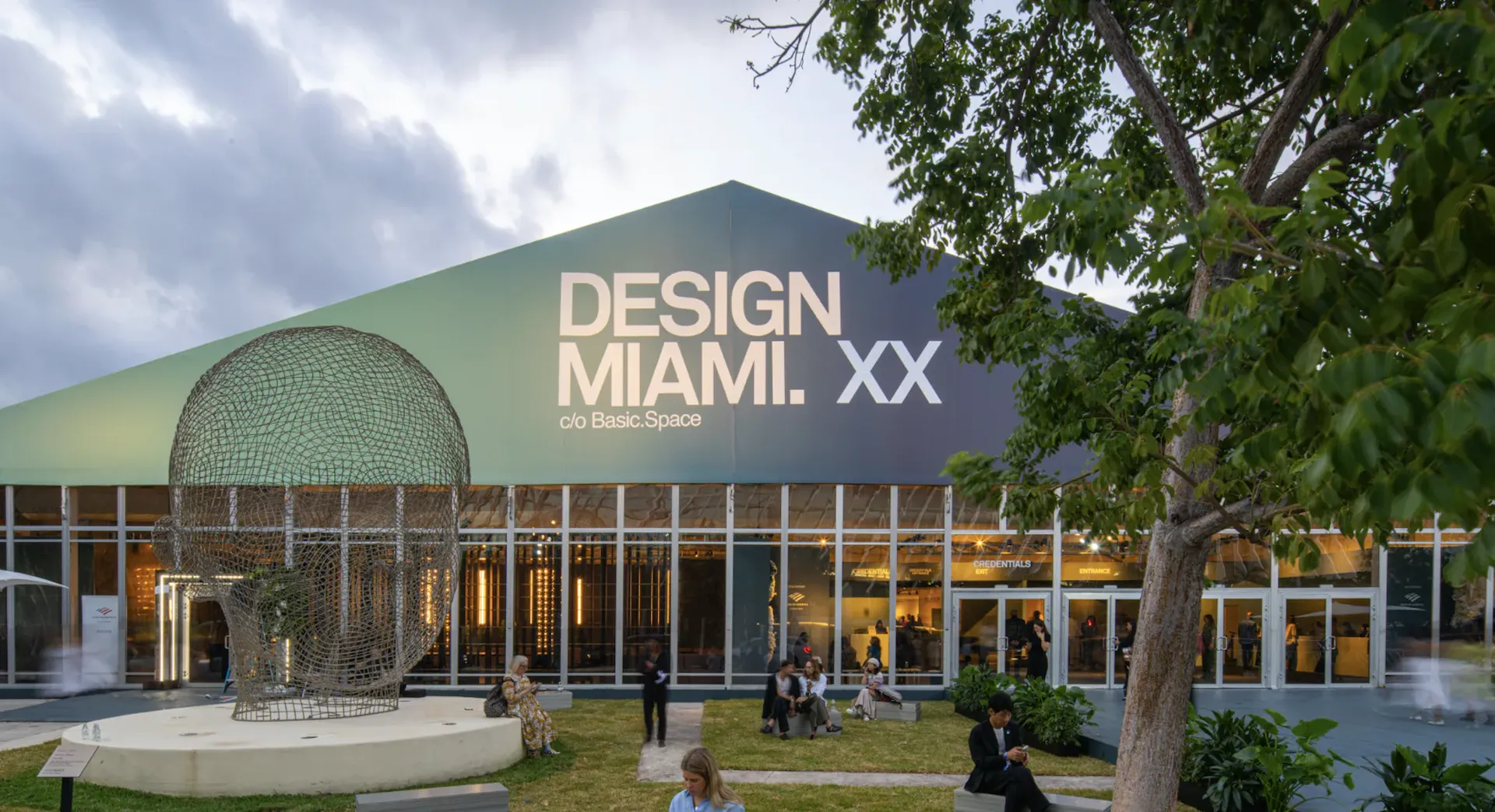Creating textiles is among the oldest human activities, and today remains a playground for innovation in terms of artistry, sustainability, craft, and digitalization. As the leading international gathering for purveyors of textiles, fibers, and materials, Heimtextil 2025 proved itself a home (or heim) for the industry as it grows and evolves.
Over 3,000 exhibitors from 65 countries flooded the sprawling halls of Messe Frankfurt in Frankfurt am Main from January 14–17, 2025, proving the omnipresence of the ancient industry with a bounty of upholstery fabrics, towels, sleep systems, wallpapers, fibers, carpets, coverings, and more. Carpets and rugs put up an impressive showing at Heimtextil 2025, tripling in number compared to last year. As the fair grows, so does the craft of textile production itself, incorporating digital design, robotic weaving, and generations-old handcraft techniques.
- At Heimtextil 2025, architect and designer Patricia Urquiola unveiled “among-us,” an installation that exemplifies how expertise in material development and visionary design can drive meaningful change.
- “Among-us” showcases Patricia’s holistic approach to design, celebrating materiality and versatility. Photos by Daniele Anside
“Especially in challenging times, Heimtextil offers companies the opportunity to strengthen their market position: through international visibility, the identification and realization of potential and the development of new global business partners,” says Detlef Braun, member of the Executive Board of Messe Frankfurt. The 50,000 attendees found opportunities for connection on 16 exhaustingly large and packed trade show floors dedicated to the fair.
The 2025 edition caught our attention thanks to two collaborations that bring design to the forefront of the textile fair more than ever. Patricia Urquiola, whose prolific body of work always ranks among our favorites each year at Salone del Mobile. Milano, exhibited a textile interior design installation full of “gentle monsters,” bright colors, and interesting textures. Across the Messe, Alcova co-founders Joseph Grima and Valentina Ciuffi brought their eye for the up-and-coming and influential to the fair’s central forecasting space, the Trend Arena.
We slogged our way through the exhibition halls to enjoy the best of the textile fair. Here’s where we spent our time:
Patricia Urquiola’s “among-us” Textile Design Installation
Designer/architect Patricia Urquiola led us through her “among-us” installation, a collaboration with Kettal, Moroso, Kvadrat, Aquafil, cc-tapis, and Cimento. The idea behind “among-us” was to create a space for congregation that layers research in color, material, tufting, and weaving techniques to combine the traditional and the futuristic in one, unified, playful 650 square meter space.

“The name ‘among-us’ conveys a sense of conviviality and shared experiences–something that happens ‘between us’ or ‘in our midst’. It also alludes to a line of small fungus-like toy creatures,” Patricia says. Photo courtesy of Heimtextil
“There is no one future. There is a lot of different research to be blended together. Let’s put together what we can do at this moment,” Patricia explained, standing in the installation’s outer section, a digital-like grid topped with vibrant lilac and magenta Kettal Insula sofas. She led us to the vertical tapestries depicting “gentle monsters”—inspired by worms, buffaloes, and let your imagination decide what else—which were digitally designed and made with cc-tapis’ tufting robot.
She had us remove our shoes to break into the boundaries of the space, stepping onto a squishy carpeted floor to enjoy the inner section of the installation. The cozy space became a focal point of the fair over the days to follow—as the fair’s champion of textile design and as a relief for exhausted feet.
The “Future Continuous” Trend Forecast by Alcova
Joseph Grima introduced his and Valentina’s approach to the Trend Arena: “We are not a traditional trend forecaster, but a curator of emerging design.” We typically find Alcova’s curations inside unusual, dilapidated locations like hospitals, slaughterhouses, factories, and motels, so we were surprised to hear Joseph say that they felt at home in the massive convention center.
Yet the exhibition was undeniably aligned with what we expect from the Alcova team: Joseph’s studio, Space Caviar designed the exhibition with swatches of textiles on a conveyor belt-like white table, a laundry line of fabrics circling overhead—“a reflection of this circularity and the idea that trends come in and out of consciousness”—and robotic arms designed by Studio AATB, designers Andrea Anner and Thibault Brevet, “playing” with the fabrics. Designed by Valentina’s Studio Vedèt, a publication detailing their conversations and thought process offered conceptual glue for the space.

Joseph Grima’s studio Space Caviar designed this exhibition with swatches of textiles on a conveyor belt-like white table, a laundry line of fabrics circling overhead. Robotic arms designed by Studio AATB, designers Andrea Anner and Thibault Brevet, “play” with the fabrics. Photo by Piergiorgio Sorgetti
What Fabrics Are on Trend?
Joseph and Valentina spoke with a number of visionary creative forces about the circularity of trends and examined thousands of textiles from Heimtextil exhibitors to generate their color palette and series of concepts to describe this moment’s particular rotation in the trend cycle.
The first of three major trends they identified is “Regenerative,” championing textiles whose every fiber is sustainability- and circularity-oriented. “Radically reconstructed” refers to the new technologies and legislation that are transforming the textile industry. Finally “naturally uneven” notices the shifting perception of beauty: away from industrial uniformity, toward irregularity as a sign of authenticity.
Trends and Transparency in Rugs and Carpets
With the carpets and rugs sector’s tripling this year, the Messe created a lounge space with exhibitors’ rugs displayed on every surface. Chowing on a pretzel in its midst, we noted the proliferation of several concrete aesthetic trends we heard in a talk by COVER Magazine editor Lucy Upward. Art rugs, pops of red, and traditional weaving techniques each abounded in the space—though separately, for the most part.
- “There has been a notable revival in the use of natural fibers in design because of their unique properties which have been valued for centuries: durability and comfort. Some of the plants that were overshadowed by cotton are really making a resurgence. Hemp, jute, flax and nettle,” says Ilse Crawford, designer, teacher, and creative director.
- Transparency is also a growing influence on the carpet industry. Experts hope certifications act as a tool by which to improve social responsibility and sustainability. Photos by Piergiorgio Sorgetti
Transparency is also a growing influence on the carpet industry and the subject of our next stop: a panel discussion on sustainable carpets with Reto Aschwanden from NGO Label STEP, Theresa Paulig from Paulig Schwarzach, and Aditya Gupta from The Rug Republic. Reto says he hopes certifications act as a tool by which to improve social responsibility and sustainability. Aditya notes that although the progress necessary to achieve a new certification can exceed the natural pace of development in his industry, they always push companies in a positive direction.
Consumer expectations can also be slow to adjust. “Everyone wants a sustainable product, but they don’t necessarily want to pay more. That’s not realistic; someone will always pay the price,” Theresa says. She draws a connection between accessibility and overconsumption: “It takes a lot to cut back and consume more thoughtfully. It takes time, but we are growing up as a society,” she says.
Econogy Tour
To say that sustainability is a trend at Heimtextil would be both an understatement and an over exaggeration. Sustainability is simply foundational since the textile industry necessarily produces waste and encourages consumption.
- From Naturally Uneven Green to End of Petrol and Imperfect Pink – the Heimtextil Trends 25/26 present a visionary colour palette that Alcova has interpreted both visually and linguistically.
- Inspired by the six expert interviews, the colors interweave the ideas and concepts that came up in the discussions. In this way, they tell a vivid story. Natural, unbleached tones meet dynamic, vibrant colors and reflect the tension between tradition and innovation. Photos by Piergiorgio Sorgetti
Sustainability consultant Bernd Müller works with Heimtextil’s Econogy FINDER, in charge of identifying exhibitors who are truly doing their part. He references the well-known 10/20/30 statistics: the textile industry can be traced back as the source of 10% of global greenhouse gas emissions, 20% of global water pollution, and 30% of the microplastics released into the environment.
“There has been progress, but not much. The circular economy in textiles has just a 1% recycling rate,” Bernd says. He pointed out three brands doing it well: Nxtile, which makes products using 100% recycled cotton; Lenzing, whose flagship brand Tencel is made of fibers derived from wood in a closed loop production process; and Piubelle, which prioritizes sustainable fibers and production processes in its products, often receiving certification from the Global Organic Textile Standard (GOTS).
Interior Architecture Materials Library
For the hospitality side of the business, Heimtextil brought together an expert panel to curate the Interior Architecture Hospitality Library, highlighting fabrics possessing six functional properties: flame-retardant, antimicrobial, stain-resistant and water-repellant, sound absorbing, lightfast, and hard-wearing. In the Messe, a physical showcase highlighted several of the selected textiles, showing the diversity of aesthetics with true functionality. The library remains a resource for interior designers, architects, and hospitality experts online.

Alcova founders Valentina Ciuffi and Joseph Grima curated “Future Continuous,” this year’s Heimtextil Trend programming. Understanding the connection between past and present as an unbroken continuity, they dove deep into the history of fabrics to explore their futures. Photo courtesy of Heimtextil
Textiles and Research by Students at Heimtextil 2025
Expert judges chose three student projects to recognize in the Heimtextil University Contest. My favorite was a knitted acoustic treatment made from recycled yarns, offering a circular acoustic solution. Kateryna Basiuk from Lucerne University of Applied Sciences and Arts in Switzerland found a 2020 study showing the microscopic, waffle-like structured surface of moth wings, a feature that allows the camouflage experts to escape echolocation by bats. Inspired by the similarity between her knitting and the microscopic texture of the wings, Kateryna explored the acoustic possibilities further to come up with “Silent Canvas,” which she presented at the Messe.









